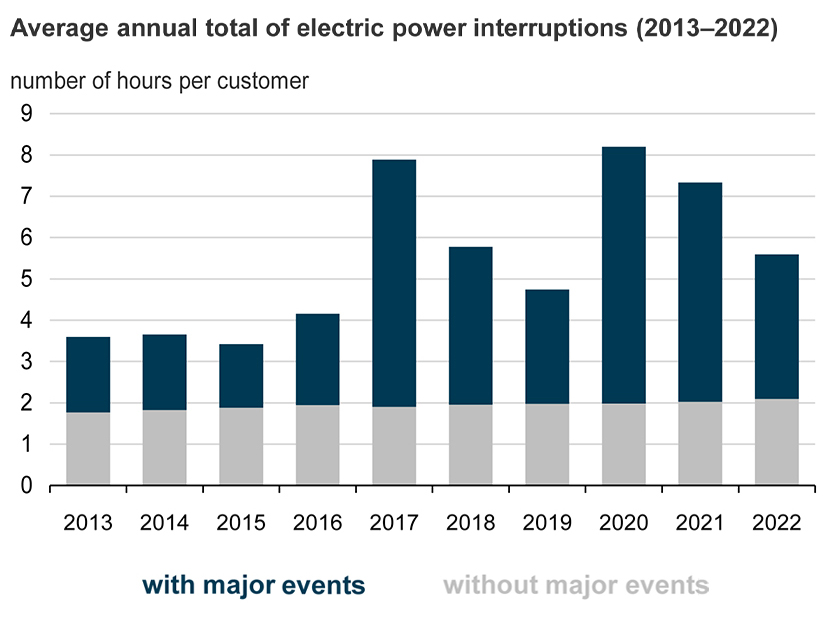I was minding my own business the other day when The Wall Street Journal ran a special section with the lead article “Five Ways to Disaster-Proof the Energy Grid.”
The article starts out claiming that recent extreme weather has pushed the “aging, overtaxed” grid to its limits, with outages “wreaking havoc on homeowners and businesses.” The alleged culprit is climate change, which is said to get worse.
Flawed Evidence
The only empirical evidence given for these claims is data from the Climate Central organization purporting to show that widespread power outages have doubled from the early 2000s to the period 2014-2023. The problem with this data is that — per Climate Central itself in an earlier report — stricter Energy Information Administration (EIA) reporting requirements were widely implemented after 2003, so the years 2000-2003 must be disregarded in order to have apples to apples. If one looks at Climate Central’s data for the 10-year period 2004-2013 and compares it with the 10-year period 2014-2023, the average number of outages goes from 78 per year to 91 per year. Not much difference.
An authoritative data source not mentioned by the Journal is the EIA, which has reported average annual hours of outage (aka interruption) per electricity customer from 2013 to 2022. That chart is reprinted here. The bottom part of each column shows the average outage hours without major events (principally weather); these basically are unchanged over 10 years, which suggests the grid is not “aging” and “overtaxed.” My past articles disproving Chicken Little claims about the grid are here and here.
The top part of each column adds the average hours with major events (principally weather). The trend seems up, but not dramatically so.
And let’s put the average 5.5 hours of customer outage in 2022 in perspective. That’s 99.94% reliability (5.5 divided by 8,760). Not “wreaking havoc” on customers — contrary to the Journal’s claim.
Wrong Target
Credibility doesn’t improve with the Journal’s suggested ways to “disaster-proof the grid.” For starters, anyone who wants to know anything about “disaster-proofing the grid” should consult experts at NERC, the Institute of Electrical and Electronics Engineers (IEEE) and the national laboratories.
The experts would explain that more than 90% of customer outages originate on local distribution systems, not the transmission/generation bulk power system (BPS). This is important because all of the Journal’s suggested ways to “disaster-proof the grid” are exclusively or predominantly tied to the BPS. Thus, even if they were sensible (which they’re not, per below), they would have a negligible effect on customer outages.
Now, let’s look at each one individually.
Artificial Intelligence
The Journal’s first suggested way to “disaster-proof the grid” is (of course) AI, which is said to enable better predictions to help better plan for extreme weather. My favorite example is replacing copper wiring with fiber-optic cable at substations vulnerable to flooding. The story says fiber-optic cable is “more resilient to saltwater and can be replaced more quickly if need be.”
Minor problem: Fiber-optic cable does not conduct electricity. Oops!
By the way, if anything will “overtax” the grid, it will be AI. How ironic.
Batteries
Moving on, the Journal’s second way to “disaster-proof the grid” is “bolstering batteries.” Right. I’ve explained why batteries are an incredibly profligate way to provide carbon-free reliability. In May I estimated the annual costs of covering renewable droughts in a carbon-free California relative to other no/low carbon options:
-
- Long-duration battery storage: $23.9 billion
- Gas plants with carbon credits: $1.1 billion
- Gas plants with CCS credits: $1.6 billion
- Gas plants with CCS retrofit: $4.4 billion
See the difference?
Microgrids
The Journal’s third suggested way is microgrids. As I explained nine years ago, microgrids ignore the incredible efficiency of grid integration. The latest, greatest microgrid is an incredible waste of Commonwealth Edison customers’ money.
Microgrids at U.S. military bases actually reduce national security by substituting microgrids for building-specific backup generation that — unlike a base microgrid — is not vulnerable to distribution-level outages (which make up 87% of all base outages) and cybersecurity threats.
Advanced Conductors
The fourth way given is “better, stronger transmission lines.” Yes, we’ve known for years that reconductoring with advanced conductors can increase transmission capacity on existing lines, and I’ve been a fan. But the various options come with their own varying characteristics (such as “rated breaking strength”), as this report shows. Could they somehow “disaster-proof” the grid or even the BPS? No way.
Demand Response
The fifth way given is “controlling demand,” aka demand response. Demand response is best understood as a counterpart to generation resources — reducing demand on command is the flip side of increasing generation on command. Yes, of course, economic demand response should be implemented, just like all economic resources that can be called upon when needed. But DR can no more “disaster-proof the grid” than other dispatchable resources.
The irony is that those ostensibly concerned with grid reliability want to eliminate dispatchable generation resources (gas, oil, coal), thereby enabling, rather than avoiding, future disasters.
OK, I’ll stop ranting.
Columnist Steve Huntoon, a former president of the Energy Bar Association, has practiced energy law for more than 30 years.



